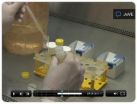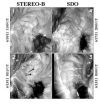(Press-News.org) A North Carolina State University researcher has developed a more efficient, less expensive way of cooling electronic devices – particularly devices that generate a lot of heat, such as lasers and power devices.
The technique uses a "heat spreader" made of a copper-graphene composite, which is attached to the electronic device using an indium-graphene interface film "Both the copper-graphene and indium-graphene have higher thermal conductivity, allowing the device to cool efficiently," says Dr. Jag Kasichainula, an associate professor of materials science and engineering at NC State and author of a paper on the research. Thermal conductivity is the rate at which a material conducts heat.
In fact, Kasichainula found that the copper-graphene film's thermal conductivity allows it to cool approximately 25 percent faster than pure copper, which is what most devices currently use.
Dissipating heat from electronic devices is important, because the devices become unreliable when they become too hot.
The paper also lays out the manufacturing process for creating the copper-graphene composite, using an electrochemical deposition process. "The copper-graphene composite is also low-cost and easy to produce," Kasichainula says. "Copper is expensive, so replacing some of the copper with graphene actually lowers the overall cost."
###The paper, "Thermal Conductivity of Copper-Graphene Composite Films Synthesized by Electrochemical Deposition with Exfoliated Graphene Platelets," is published in Metallurgical and Materials Transactions B. The research was funded by the National Science Foundation.
Researcher finds faster, cheaper way to cool electronic devices
2012-04-10
ELSE PRESS RELEASES FROM THIS DATE:
New poll shows New York voters support global health research but unsure where it is conducted
2012-04-10
WASHINGTON—April 9, 2012— New York voters recognize the importance of global health research and are concerned about the United States' ability to compete globally, according to a new poll commissioned by Research!America, yet an overwhelming majority (93%) of those polled don't know where global health research is conducted in their own state.
The majority of New Yorkers (64%) think that New York residents should be concerned about global health and an additional 63% believe that spending money on global health is important to their state's economy. However, poll results ...
'Nanobubbles' plus chemotherapy equals single-cell cancer targeting
2012-04-10
HOUSTON -- (April 9, 2012) -- Using light-harvesting nanoparticles to convert laser energy into "plasmonic nanobubbles," researchers at Rice University, the University of Texas MD Anderson Cancer Center and Baylor College of Medicine (BCM) are developing new methods to inject drugs and genetic payloads directly into cancer cells. In tests on drug-resistant cancer cells, the researchers found that delivering chemotherapy drugs with nanobubbles was up to 30 times more deadly to cancer cells than traditional drug treatment and required less than one-tenth the clinical dose.
"We ...
Researchers identify genes that may help in ovarian cancer diagnosis and prognosis
2012-04-10
Philadelphia, PA, April 9, 2012 – Scientists from Duke University Medical Center have determined that genes acting as molecular "on/off" switches can define clinically relevant molecular subtypes of ovarian cancer, providing ideal potential targets for use in clinical prognostic and diagnostic testing. These bimodal genes can define tumor subtypes that have different overall prognoses and respond to different therapeutic regimens. The researchers' results are published in the May issue of The Journal of Molecular Diagnostics.
"We identified a very small set of genes ...
A better tool to diagnose tuberculosis
2012-04-10
Up to 30% of the world's population is infected with Tuberculosis (TB), but in many areas of the world, TB diagnosis still relies on insensitive, poorly standardized, and time-consuming methods. A new diagnostic tool, endorsed by the World Health Organization (WHO), may change that. Dr. Thomas Bodmer shows how it's done in the Journal of Visualized Experiments (JoVE).
Currently, TB is diagnosed through either a skin test, which produces a small bump on the patient's arm when administered and needs to be checked after 72 hours, and through smear microscopy, a method that ...
WirelessTimeClock.com Launches Redesigned Site
2012-04-10
WirelessTimeClock.com, a trusted source for web-based time clocks, has re-launched its website (http://www.wirelesstimeclock.com) with a more intuitive and streamlined design, promising a more enriching experience for businesses searching for reliable employee time clocks and time and attendance management solutions.
"Our customers have been asking for a more intuitive, resourceful site," says Scott Tobin, owner of WirelessTimeClock.com. "We wanted to make sure they could find exactly the clocks and monthly plans that would fit their business needs."
With ...
High-resolution atomic imaging of specimens in liquid by TEM using graphene liquid cell
2012-04-10
Daejeon, the Republic of Korea, April 9, 2012—The Korea Advanced Institute of Science and Technology (KAIST) announced that a research team from the Department of Materials Science and Engineering has developed a technology that enables scientists and engineers to observe processes occurring in liquid media on the smallest possible scale which is less than a nanometer.
Professor Jeong Yong Lee and Researcher Jong Min Yuk, in collaboration with Professor Paul Alivisatos's and Professor Alex Zettl's groups at the University of California, Berkeley, succeeded in making ...
Normalizing tumor blood vessels improves delivery of only the smallest nanomedicines
2012-04-10
Combining two strategies designed to improve the results of cancer treatment – antiangiogenesis drugs and nanomedicines – may only be successful if the smallest nanomedicines are used. A new study from Massachusetts General Hospital (MGH) researchers, appearing in Nature Nanotechnology, finds that normalizing blood vessels within tumors, which improves the delivery of standard chemotherapy drugs, can block the delivery of larger nanotherapy molecules.
"We found that vascular normalization only increases the delivery of the smallest nanomedicines to cancer cells," says ...
SDO and STEREO spot something new on the sun
2012-04-10
One day in the fall of 2011, Neil Sheeley, a solar scientist at the Naval Research Laboratory in Washington, D.C., did what he always does – look through the daily images of the sun from NASA's Solar Dynamics Observatory (SDO).
But on this day he saw something he'd never noticed before: a pattern of cells with bright centers and dark boundaries occurring in the sun's atmosphere, the corona. These cells looked somewhat like a cell pattern that occurs on the sun's surface -- similar to the bubbles that rise to the top of boiling water -- but it was a surprise to find this ...
Atlanta Hardwood Flooring Can Be "Baby-Proof" If Done By FlooringAtlantaNow.com
2012-04-10
It shouldn't be surprising to those who have children, that Atlanta Hardwood Flooring is constantly in harm's way from rambunctious babies! The experts at FlooringAtlantaNow are truly masters of the trade, and most recommend using more durable types of wood for high-traffic areas of your home which are prone to scratches or abrasions.
Most Atlanta Flooring specialists agree that winter is the best time to do these types of installations and upgrades to your home. Because metro-Atlanta is known for its mild winters, the season offers a perfect climate which tends to be ...
Black flies may have a purpose after all
2012-04-10
Athens, Ga. – Black flies drink blood and spread disease such as river blindness—creating misery with their presence. A University of Georgia study, however, proves that the pesky insects can be useful.
Don Champagne, an entomology professor with the UGA College of Agricultural and Environmental Sciences, discovered a way to use the black fly's blood-sucking tactics for medical advancement. The results of his research were published in the journal PLoS One.
"In order to feed on blood, these insects have to contend with our natural defense agents against blood loss—like ...



